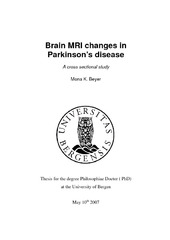| dc.description.abstract | Background: Cognitive impairment is common even in newly diagnosed Parkinson’s disease (PD), and characteristically involves executive and visuospatial functions with deficits also in the memory domain. There is an increased risk of dementia associated with the diagnosis of PD, with an almost sixfold increased risk of becoming demented compared with subjects without PD. The morphologic changes of grey and white matter which accompany cognitive impairment in early PD, and dementia in PD are incompletely understood. The first study to compare whole brain atrophy in PD versus other types of dementia was published in 2004, showing that the pattern of grey matter loss in PD and PDD was different from the changes found in AD. Occipital atrophy was found in the PDD group and frontal volume loss in PD without dementia. No difference in grey matter volume was found between PDD and DLB patients. The studies that have been published since, have in part confirmed these results, but also conflicting results have been found. No studies have previously looked at white matter hyperintense lesions in MR images of PD patients and their impact on dementia in PD. Hypotheses: The frequency and extent of white matter T2 hyperintense lesions (WMH) are associated with dementia in PD. The pattern of grey matter atrophy in PD is different from atrophy in normal ageing, patients with PDD and PD with mild cognitive impairment. Grey matter atrophy in patients with PDD differs from the pattern of atrophy in patients with Alzheimer’s disease but not from patients with Dementia with Lewy Bodies. Patients with PD who develop dementia early in the disease diagnosis have more grey matter atrophy than patients who develop dementia late in the disease course. Subjects: Patients were recruited by doctors in the outpatient clinics of the Department of Neurology, Department of Geriatric Medicine and the Department of Old Age Psychiatry at Stavanger University Hospital in the period from 2001 to 2005. One group was recruited from an ongoing longitudinal study, the Parkinson-study of Rogaland, during their annual follow up (n= 17). Another group consisted of consecutive patients with PD with and without dementia. Patients with Alzheimer’s disease and DLB were also recruited. Healthy elderly volunteers were recruited from Stavanger and the surrounding district. Methods: After a clinical assessment including evaluation of cognition, motor symptoms and psychiatric symtoms patients were diagnosed according to established diagnostic criteria for PD and dementia. Healthy controls completed a brief interview and a mini mental state evaluation (MMSE). All patients and controls completed an MRI examination with the same imaging protocol, in the same MRI machine. Images were analysed for white matter hyperintense lesions (WMH) using a semiquantitative visual rating scale. Unbiased whole brain image analysis with voxel based morphometry (VBM) was used for the evaluation of grey matter differences between groups. Results: We found that white matter hyperintense lesions in T2 weighted series on MRI are not increased in number or extent in the total PD group, but they were increased in in PDD compared to non-demented PD subjects. We found atrophy in PDD both in cortical and sub cortical grey matter compared to healthy subjects and non-demented subjects with PD. A novel finding was atrophy in grey matter observed in patients with MCI and PD compared to subjects with PD and intact cognition, indicating that even the early cognitive changes in PD are associated with morphological brain changes. The overall pattern of grey matter changes in PDD differed from that in AD and DLB, although overlapping regions of atrophy exists. In our study, DLB patients had more atrophy in parietal and occipital areas compared with PDD patients. We found that patients with PD who developed dementia early had a different pattern of atrophy than those who developed dementia late in the course. Conclusion: We found that there is no increase in WMH in PD compared to controls. The more severe changes found in PDD however, suggests that in some patients WMH may contribute to cognitive impairment. Our grey matter findings are in line with other studies, supporting the hypothesis that morphological changes in the cortex contribute to dementia in PD. We found grey matter structural changes associated with cognitive impairment in PD, thus cognitive impairment early in PD are not entirely based on functional changes. Differences found between DLB and PDD shed light on the ongoing discussion whether DLB and PDD are different diseases or represent stages on a continuum of Lewy body disease. The results of the studies included in this thesis, gives valuable new information about structural changes accompanying PD both in white matter and grey matter, and our results give rise to new hypotheses for future imaging studies of PD. Challenges for future studies will be to find which brain changes that reliably can predict development of dementia in PD. | en_US |
